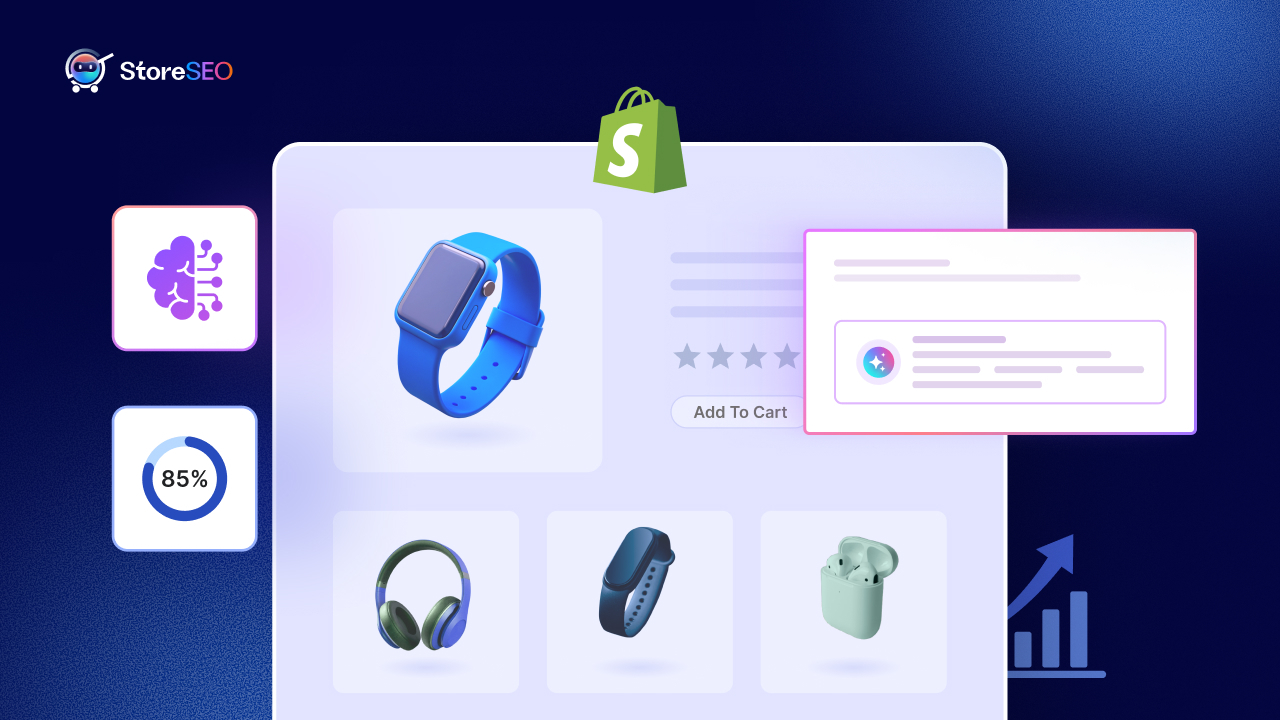Businesses nowadays are no longer limited by geographical boundaries. The growth of the Internet has made it possible for companies to reach customers from all over the world. However, one of the biggest challenges in this global expansion is language. This is where multi-language SEO for Shopify comes into play. In this blog, we will explore the essential factors regarding Multilingual SEO and other factors that impact it. Let us get started.

What is Multi-Language SEO?
Multi-language SEO is the process of optimizing your website’s content to rank well in search engines across multiple languages. It involves creating and optimizing content in different languages to cater to diverse audiences worldwide. This approach helps businesses overcome language barriers and connect with potential customers who search the web in their native languages.
Why is Multi-Language SEO Crucial for Shopify Stores?
For Shopify stores, multi-language SEO is essential for several reasons once you know the reasons make sure to align them properly:
Enhanced Customer Experience
When customers can shop in their native language, they feel more comfortable and engaged. This leads to a better overall experience, as they can easily understand product descriptions, navigate the site, and make informed purchasing decisions.
A well-optimized multilingual store builds trust with customers, which is crucial for long-term loyalty and repeat business.
Better Search Rankings
Search engines like Google prefer content that is relevant to the user’s language and location. By optimizing your Shopify store for multiple languages, you increase the chances of your pages ranking higher in search results across different regions.
This means more visibility for your store, which translates into increased organic traffic and potential sales.
Increased Conversions
Studies have shown that customers are more likely to purchase from websites that offer content in their native language. This is because they feel more confident in their understanding of the products and the purchasing process.
By providing localized content, you can reduce uncertainties and increase the likelihood of customers completing their purchases.
Competitive Advantage
Many Shopify stores are available only in English, which means there is a significant opportunity for businesses that offer multilingual options to stand out from the competition.
By catering to a broader audience, you can attract customers who might otherwise be inaccessible due to language barriers.
Technical Optimization Strategies for Multilingual SEO on Shopify
Optimizing your Shopify store for multiple languages is a great way to reach more customers worldwide. However, it requires some technical tweaks to ensure search engines understand and rank your content correctly. Let’s dive into the essential strategies for technical optimization.
Use of Hreflang Tags
Hreflang tags are small pieces of code that tell search engines about the different language versions of your website. They help search engines understand which version of a page is most relevant to a user based on their language and location. For example, if you have a page in English for the United States and another in Spanish for Spain, hreflang tags will guide search engines to show the correct version to users in each country.
Why are Hreflang Tags Important?
These tags are crucial for avoiding duplicate content issues, which can harm your SEO. By using hreflang tags, you signal to search engines that each version of your page is unique and intended for a specific audience. This improves user experience and boosts your site’s visibility in search results.
You can add hreflang tags directly in the HTML of your page. This involves inserting a line of code in the <head> section of your page.
For example:
xml
<link rel=”alternate” href=”https://example.com” hreflang=”en-us” />
<link rel=”alternate” href=”https://example.com/es” hreflang=”es-es” />
This tells search engines that the first link is for English-speaking users in the United States and the second is for Spanish-speaking users in Spain. You can also include hreflang tags in your XML sitemap. This method is useful if you have many pages and want to manage them centrally.
URL Structure for Multi-Language SEO for Shopify
When creating a multilingual Shopify store, choosing the right URL structure is vital for SEO. You have three main options: subdomains, subdirectories, and country-code top-level domains (ccTLDs).
Subdomains vs. Subdirectories
- Subdomains: These are like mini-websites within your main site. For example, fr.example.com for French content. Google treats subdomains as separate sites, which can dilute your SEO efforts if not managed carefully.
- Subdirectories: These are folders within your main domain. For example, example.com/fr for French content. Subdirectories are generally better for SEO because they inherit the authority of your main domain, making it easier to rank in search engines.
Best Practices for URL Structure
- Use Subdirectories: Unless you have a specific reason to use subdomains (like needing separate technical configurations), subdirectories are usually the best choice for multilingual content.
- Keep it Simple: Ensure your URLs are short and easy to read. This helps users and search engines understand your site structure better.
- Use Language Codes: Include language codes in your URLs to clearly indicate the language of each version. For example, example.com/en for English and example.com/fr for French.
Page Speed Optimization for Multi-Language SEO for Shopify
Page speed is crucial for SEO, regardless of the language. Faster sites improve user experience and search rankings. Here are some tips to optimize your multilingual Shopify store’s speed:
Tips for Optimization
- Optimize Images:
- Use tools like TinyPNG or Shopify’s built-in features to compress images without losing quality.
- Use next-gen image formats like WebP for better compression.
- Implement lazy loading to load images only when they appear on the screen.
- Utilize Browser Caching:
- Enable browser caching to store static files locally on users’ devices. This reduces the need for repeated downloads and speeds up subsequent visits.
- Use Shopify’s built-in caching features or third-party apps to manage caching settings.
- Use Content Delivery Networks (CDNs):
- CDNs distribute your site’s content across multiple servers worldwide, ensuring fast delivery of assets to users regardless of their location.
- Shopify offers a built-in CDN, so make sure to utilize it effectively.
Content Optimization Strategies for Multi-Language SEO for Shopify
When it comes to optimizing your Shopify store for multiple languages, creating content that resonates with local cultures and trends is crucial. This involves more than just translating your website; it requires a deep understanding of the local audience’s preferences and behaviors. Let’s dive into the key strategies for content optimization.
Localized Content Creation
Localized content creation is about tailoring your content to fit the cultural and linguistic nuances of your target audience. This means going beyond mere translation to ensure that your content is relevant and engaging for local users.
Why Localized Content Matters
- Cultural Relevance: Different cultures have unique customs, traditions, and idioms. For example, a phrase that works well in English might not have a direct equivalent in another language. Localized content ensures that your message is conveyed in a way that resonates with the local audience.
- Improved Engagement: When content feels familiar and relevant, users are more likely to engage with it. This can lead to higher conversion rates and better brand loyalty.
- Competitive Advantage: By offering content that is tailored to local preferences, you can differentiate your brand from competitors who may only offer generic translations.
Translating Metadata and Keywords
Metadata, such as page titles and descriptions, are crucial for search engine optimization (SEO). Accurately translating these elements is essential for improving your website’s visibility in local search results.
- Metadata Translation: Ensure that your metadata is translated in a way that maintains the original intent while adapting to local search behaviors. This includes using local keywords and phrases that have high search volumes.
- Keyword Translation: Keywords should be translated with care, considering local language nuances and search trends. For instance, a keyword that is popular in one region might not be as relevant in another.
Keyword Research for Multi-Language SEO for Shopify
Conducting keyword research in multiple languages is a vital step in optimizing your content for global audiences.
Steps for Multilingual Keyword Research
- Analyze Seed Keywords: Start by identifying core keywords in your source language, typically English. These should be related to your products or services.
- Generate Localized Keywords: Translate these keywords into your target languages and adapt them to fit local search trends. This might involve using local slang or idiomatic expressions.
- Collaborate with Native Speakers: Work with native speakers to refine your keyword list and ensure it aligns with local search intent.
Tools for Finding Relevant Keywords
Several tools can help you find and analyze keywords in multiple languages:
- Google Keyword Planner: Offers insights into search volumes and trends, helping you identify relevant keywords.
- SEMrush and Ahrefs: Provide comprehensive databases of keywords and competitor analysis, useful for advanced SEO strategies.
- KWFinder: Specializes in finding low-competition keywords, ideal for exploring new markets.
Content Management Tools
Utilizing Shopify’s multilingual apps can simplify the process of managing content across different languages.
Benefits of Multilingual Apps
- Seamless Translation: These apps often provide automated translation services, making it easier to create content in multiple languages.
- Localized Content Management: They allow you to manage and update content for different regions from a single dashboard, ensuring consistency and efficiency.
- SEO Optimization: Many apps also offer features to optimize your content for local SEO, including metadata translation and hreflang tags setup.
Trusted Apps for Multilingual SEO: StoreSEO’s Multilingual SEO Support
One of the most effective ways to optimize your translated content for search engines is by using specialized apps like StoreSEO. Here, we will delve into the features and configuration process of StoreSEO’s Multilingual SEO Support.
Overview of StoreSEO’s Features
StoreSEO multilingual feature is designed to make optimizing your translated product pages easier and more efficient. The app offers a range of features that help you improve your store’s visibility in search results across different languages. Here are some of the key features:

- Meta Title and Description Optimization: StoreSEO allows you to optimize the meta titles and descriptions of your translated product pages. This is crucial because these elements are what users see in search engine results pages (SERPs), and they play a significant role in determining whether users click through to your site.
- Focus Keyword Management: You can set and optimize focus keywords for each translated product page. This ensures that your content is relevant to the search queries you want to rank for.
- URL Handle Customization: StoreSEO enables you to customize the URL handles of your translated product pages. This helps in creating clean, descriptive URLs that are easy for both users and search engines to understand.
- SEO Score and Analysis: The app provides real-time SEO scores and detailed analysis for your translated product pages. This helps you identify areas for improvement and track the effectiveness of your SEO efforts.
- AI Optimizer Addon: With the AI Optimizer addon, you can automatically generate meta titles and descriptions based on your focus keyword and the language of the translation. This saves time and ensures consistency across your multilingual content.
How to Configure StoreSEO for Multilingual SEO
Follow these simple steps to optimize your translated Shopify products for SEO using the StoreSEO app and get the best result out of the optimization:
Step 1: Translate Your Store’s Products
First, translate your store’s products by using Shopify’s Translate & Adapt app. This app is automatically installed when you add a new language or can be found in ‘Settings → Languages’ in your Shopify dashboard. Use it to manually or automatically translate product content into your target languages.

Step 2: Enable Multilingual SEO Support in StoreSEO
Next, enable Multilingual SEO Support in StoreSEO. Open the StoreSEO app, click on ‘View more’ in the left panel, and go to ‘Settings → Multilingual SEO’. Turn on the feature and sync your translated languages under the ‘Published Languages’ section. Once synced, you’ll receive a confirmation message.

Step 3: Optimize Your Translated Products
Finally, optimize your translated products by navigating to ‘Optimize SEO → Products’ in the StoreSEO app. Use the language selector dropdown to choose the translated language, then select a product and click ‘Fix Issue’ to optimize it.

Follow the SEO Score, Basic SEO Analysis, and Detailed SEO Analysis provided on the right side to improve its performance. You can also switch languages directly from the optimization screen.

With these steps, you can effectively optimize your translated Shopify products for better SEO results. If you need assistance, reach out to StoreSEO’s dedicated support team.
Best Practices To Boost Multi-Language SEO for Shopify Stores
Creating a multilingual Shopify store is a great way to expand your business globally. However, it requires careful planning and execution to ensure that your store resonates with customers from different linguistic backgrounds. Here are some best practices to help you achieve success:
Personalization of Your Store
Personalization is key when it comes to multilingual Shopify stores. It involves tailoring your store’s content and language options to meet the needs of your target audience.
Choosing the Right Languages for Your Target Market
When deciding which languages to support, consider the languages spoken by your existing customers and those you want to target in the future. For example, if you are planning to expand into Europe, you might want to include languages like English, Spanish, French, and German. This approach helps ensure that your store is accessible to a broader audience and enhances customer satisfaction.
Research conducted by McKinsey shows that personalization can increase customer satisfaction rates by 20% and improve conversion rates by 10-15%. Therefore, selecting the right languages is crucial for building a strong connection with your customers.
Ensuring Accurate Translations
Accurate translations are essential for maintaining the integrity of your brand’s message across languages. It is important to use professional translation services or native speakers to review your translations. Avoid word-for-word translations, as they may lose nuances and emotions that are crucial for engaging customers effectively.
Using clear and consistent language across all translations helps establish trust and credibility with your audience. This means using the same terminology and phrasing in all languages and avoiding idioms or cultural references that may not translate well.
SEO Tracking and Analytics
Monitoring your multilingual SEO performance is vital for understanding how well your store is performing in different languages. Here is how you can leverage analytics to improve your strategies:
Using Analytics to Monitor Multilingual SEO Performance
Tools like Google Analytics and Google Search Console are essential for tracking your store’s performance in multiple languages. Google Analytics provides insights into user behavior on your site, such as session numbers, traffic sources, and conversion rates. Google Search Console helps you analyze search queries, impressions, clicks, and click-through rates (CTR) for each language version of your site.
Adjusting Strategies Based on User Interaction Metrics
Once you have collected data on how your multilingual store is performing, you can adjust your strategies accordingly. For instance, if you notice that certain language versions are not attracting enough traffic, you might need to refine your keyword research or optimize your metadata for those languages.
Regularly tracking SEO metrics allows you to identify areas for improvement and make data-driven decisions to enhance your store’s visibility and engagement across different languages. This ongoing process ensures that your multilingual Shopify store remains competitive and continues to grow globally.
Have you found our blog useful? If you do, please subscribe to our blog for more tips, tutorials, and updates on industry-related topics.









